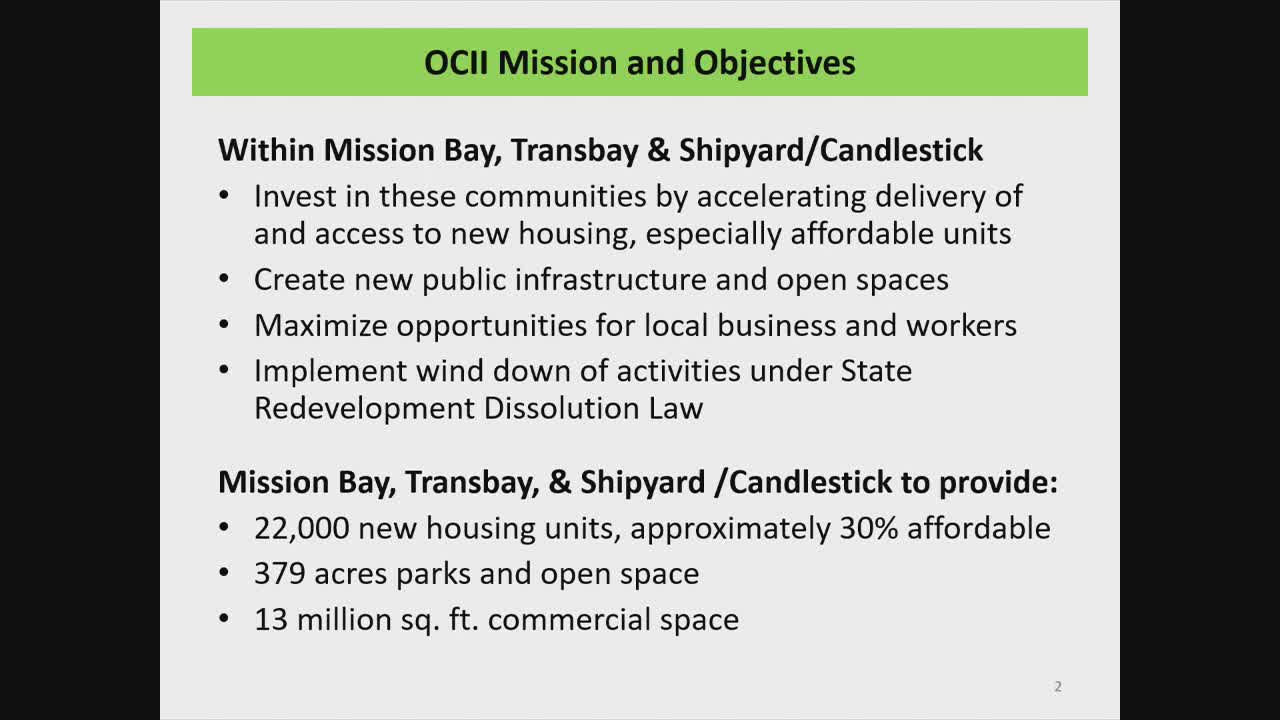City launches ambitious plan for affordable housing and parks
June 12, 2024 | San Francisco City, San Francisco County, California

This article was created by AI summarizing key points discussed. AI makes mistakes, so for full details and context, please refer to the video of the full meeting. Please report any errors so we can fix them. Report an error »

In a recent government meeting, officials outlined ambitious plans for urban development across three key areas: Mission Bay, Transbay, and the Hunters Point shipyard and Candlestick. These projects aim to leverage public-private partnerships to create significant housing opportunities, particularly affordable housing, alongside public infrastructure and parks.
The development strategy is set to produce 22,000 housing units, nearly 400 acres of parks, and 13 million square feet of commercial space. Currently, the agency is midway through its housing production, with over 300 acres of parks and half of the commercial space still to be developed.
For the fiscal years 2024 and 2025, specific projects include the completion of the 5.5-acre Bayfront Park in Mission Bay and the Mission Bay 9A homeownership project, which will provide 150 units. In Transbay, the design of the Eastcut Sports and Dog Park is underway, with construction expected to begin in 2026, alongside the development of over 300 housing units at Block 2, which broke ground last week.
In the Hunters Point shipyard and Candlestick areas, 180 units of affordable housing are slated for completion by 2025, with plans for redevelopment amendments to further enhance the Candlestick project.
The agency's budget for these initiatives stands at $685 million, with 90% allocated to direct spending on affordable housing, parks, and infrastructure. A significant portion of the budget, approximately $33 million, is dedicated to the Transbay tax pledge agreement, which supports the Transbay Joint Powers Authority.
The meeting also highlighted the agency's commitment to economic development, with a goal of 50% small business contracting and local hiring. Since its inception in 2012, the agency has administered contracts worth approximately $6 billion, resulting in nearly 50,000 jobs and $160 million in wages for San Francisco residents.
In response to committee requests, officials provided an organizational chart and acknowledged current staffing vacancies, which have increased due to COVID-19 and recent retirements. The agency is actively recruiting to fill these positions while also adhering to the mayor's directive to reduce spending, anticipating a $13 million decrease in tax increment draw for the upcoming fiscal year.
Overall, the meeting underscored the agency's proactive approach to urban development, emphasizing community engagement and economic opportunity as central tenets of their ongoing projects.
The development strategy is set to produce 22,000 housing units, nearly 400 acres of parks, and 13 million square feet of commercial space. Currently, the agency is midway through its housing production, with over 300 acres of parks and half of the commercial space still to be developed.
For the fiscal years 2024 and 2025, specific projects include the completion of the 5.5-acre Bayfront Park in Mission Bay and the Mission Bay 9A homeownership project, which will provide 150 units. In Transbay, the design of the Eastcut Sports and Dog Park is underway, with construction expected to begin in 2026, alongside the development of over 300 housing units at Block 2, which broke ground last week.
In the Hunters Point shipyard and Candlestick areas, 180 units of affordable housing are slated for completion by 2025, with plans for redevelopment amendments to further enhance the Candlestick project.
The agency's budget for these initiatives stands at $685 million, with 90% allocated to direct spending on affordable housing, parks, and infrastructure. A significant portion of the budget, approximately $33 million, is dedicated to the Transbay tax pledge agreement, which supports the Transbay Joint Powers Authority.
The meeting also highlighted the agency's commitment to economic development, with a goal of 50% small business contracting and local hiring. Since its inception in 2012, the agency has administered contracts worth approximately $6 billion, resulting in nearly 50,000 jobs and $160 million in wages for San Francisco residents.
In response to committee requests, officials provided an organizational chart and acknowledged current staffing vacancies, which have increased due to COVID-19 and recent retirements. The agency is actively recruiting to fill these positions while also adhering to the mayor's directive to reduce spending, anticipating a $13 million decrease in tax increment draw for the upcoming fiscal year.
Overall, the meeting underscored the agency's proactive approach to urban development, emphasizing community engagement and economic opportunity as central tenets of their ongoing projects.
View full meeting
This article is based on a recent meeting—watch the full video and explore the complete transcript for deeper insights into the discussion.
View full meeting
